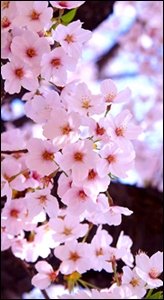 Traditionally and ideally, a haiku presents a pair of contrasting images, one suggestive of time and place, the other a vivid but fleeting observation. Working together, they evoke mood and emotion. The poet does not comment on the connection but leaves the synthesis of the two images for the reader to perceive. A haiku by the poet Bashô, considered to have written the most perfect examples of the form, illustrates this duality:
Traditionally and ideally, a haiku presents a pair of contrasting images, one suggestive of time and place, the other a vivid but fleeting observation. Working together, they evoke mood and emotion. The poet does not comment on the connection but leaves the synthesis of the two images for the reader to perceive. A haiku by the poet Bashô, considered to have written the most perfect examples of the form, illustrates this duality:Now the swinging bridge
Is quieted with creepers ...
Like our tendrilled life.
The haiku evolved from the earlier linked-verse form known as the renga and was used extensively by Zen Buddhist monks in the 15th and 16th centuries. In the next 200 years, the verse form achieved its greatest popularity and success. In addition to Bashô, important haiku poets include Yosa Buson, Kobayashi Issa, and Masuoka Shiki.
The precise and concise nature of haiku influenced the early 20th-century Anglo-American poetic movement known as imagism. The writing of haiku is still practiced by thousands of Japanese who annually publish outstanding examples in the many magazines devoted to the art.*
Read about haiku: http://en.wikipedia.org/wiki/Haiku
*Microsoft® Encarta® Encyclopedia 99 © 1993-1998 Microsoft Corporation.
2 comments:
These flowers are much like rats: when there grows one there are a lot more of them.
Kind regards,
Martijn Fransen
Thanks for stopping by my blog! I look forward to the cake post!
Post a Comment